Theme Park Business Booming
Despite a sluggish economy, Americans are flocking to theme parks and spending big bucks to stand in line.
Despite a sluggish economy, Americans are flocking to theme parks and spending big bucks to stand in line.
BloombergBusinessweek (“U.S. Theme Park Revenue Is on Its Best Ride in Years“):
The opening-day line on May 24 took four hours to get through, as it weaved past the dolphin theater and looped twice around the seal habitat. The draw was Antarctica: Empire of the Penguin, the newest attraction at SeaWorld Entertainment’s Orlando theme park. The promise of 6,000 pounds of faux snow falling daily and up-close encounters with 230 penguins persuaded thousands to queue up in the Florida heat.
Amusingly, I was across town at Disney World that day and was completely unaware that this rival event was going on. Certainly, it didn’t relieve the crowds at the Magic Kingdom, which was jam packed despite 92-degree heat.
America’s passion for amusement parks is white-hot these days, driven by elaborate new attractions, sophisticated pricing schemes, and a desire to get out of the house—but not too far from home. “You would think that a business whose proposition is selling entertainment that requires disposable income would not do well” just now, says SeaWorld Chief Executive Officer Jim Atchison. “The reality is consumers have found great value in these kinds of experiences.”
The theme park business has recovered from the recession much faster than other leisure pursuits. Revenue in the $37 billion-a-year casino industry has yet to return to its 2007 peak. And the national average price of a hotel room, at $107 a night last summer, was still below its mark four years earlier, according to Smith Travel Research. Yet theme park sales, which fell 5.5 percent, to $11.6 billion, in 2009, have come roaring back. Revenue for U.S. parks is expected to break another record at $13.4 billion this year, a 2.8 percent increase from 2012, according to market researcher IBISWorld, and climb an additional 2.4 percent annually through 2017. That compares with 1.8 percent growth from 2007 to 2012.
Part of that comes from fair hefty price increases, at least at the major venues. Plus, there are ever-more new parks and attractions.
Attribute that in part to the Harry Potter effect. Attendance at Universal’s Islands of Adventure park in Orlando jumped 66 percent between 2009 and 2011, to 7.7 million annual visitors, after it opened the Wizarding World of Harry Potter attraction. Providing guests entree to a world based on one of the planet’s most popular book and film franchises proved a potent draw, even during a sluggish economy. Parks are now the highest-margin business at Universal’s parent, Comcast, generating $953 million in operating cash flow on sales of $2.1 billion last year. Explains Tom Williams, CEO of Universal Parks and Resorts: “They buy their capes and wands and mementos of the experience. It’s a way to get away.”
It’s pretty remarkable, indeed, that operating theme parks is a higher-margin business than charging $100-plus a month to send electrons down pre-existing cables, often to customers with no alternative providers.
Walt Disney, the world’s largest theme park operator, is following a similar path. Disney tripled its investment in its resorts business between 2008 and 2012, spending a total of $9.2 billion to, among other things, refresh Fantasyland at its Magic Kingdom park in Orlando and build attractions such as Cars Land at its Disney California Adventure Park in Anaheim. The big investment on attractions featuring the popular Pixar characters turned the latter property around, with California Adventure now rivaling neighboring Disneyland in attendance. Visitors to Disney’s domestic parks climbed 8 percent in the company’s second quarter, and bookings are up 7 percent so far in the current one.
Disney, of course, its movies to capitalize on. The major new attractions at Fantasyland are a ride based on its still-popular “Little Mermaid” characters and an interactive feature with Belle from “Beauty and the Beast.” Both, naturally, are part of the Disney Princess phenomenon. To say that Disney is the biggest of the theme park companies is a dramatic understatement:
Indeed, eyeballing the chart, it would seem that Six Flags, SeaWorld, and whatever the hell Cedar Fair is have remained essentially flat; it’s Universal and Disney that constitute the entirety of this phenomenal growth. Naturally, they’re hiking prices:
The increasing demand has allowed operators to raise prices. Disney hiked the cost of its premium annual pass to Disneyland and California Adventure by 30 percent last year, to $649. (Daily Disneyland admission is $87 vs. $41 in 2000.) SeaWorld, eyeing the bump it would get from the Antarctica attraction, raised its Orlando annual pass price 24 percent, to $149, in January.
Judging from the crowds at Disney during the Memorial Day weekend period, prices are still too low. We went to the Magic Kingdom twice, Epcot, Animal Kingdom, and Typhoon Lagoon—all Disney properties—and they were all so packed as to severely sap the enjoyment of the experience. Some of the more popular attractions had two- and three-hour wait times; one was in excess of four hours. Outside the water parks, there’s the ability to get a Fast Pass for some of these, but it requires advance planning and guesswork. And the water park was so crowded by the afternoon that some of the attractions were essentially unusable; you can’t float down a lazy river when it’s wall to wall with people.
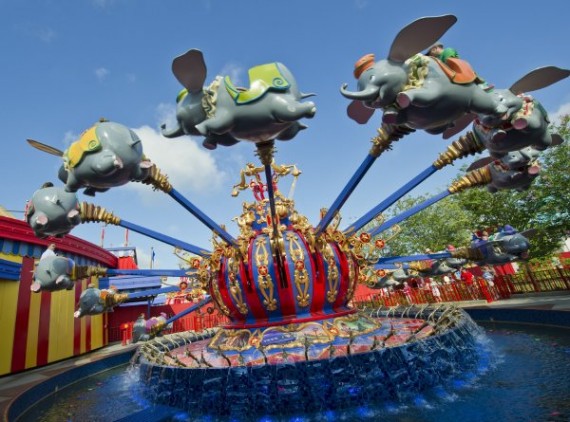
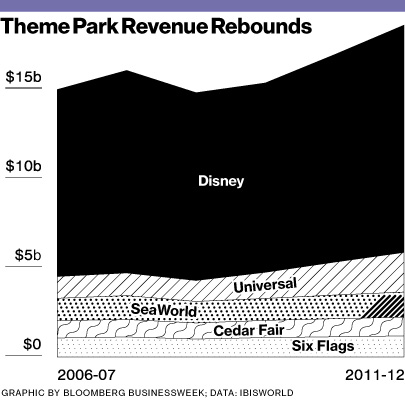

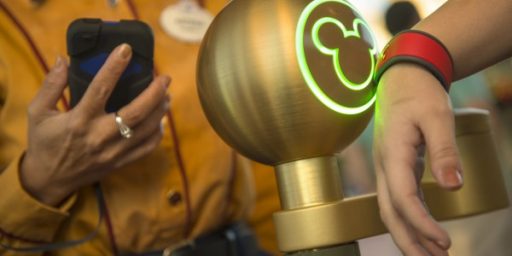
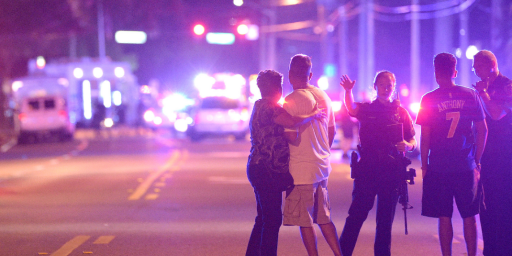
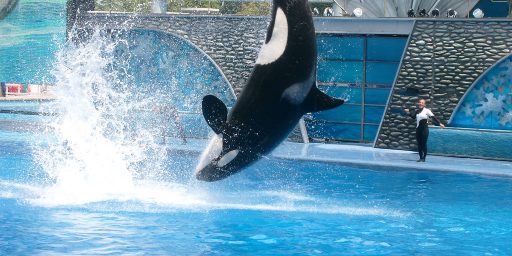


@James Joyner:
You should just have hired a disabled person, then you only have to wait for one minute. (That story might not be true though….)
The wife was talking about taking our grand baby to Disney world and all I could think was, “Uuuuuukkkkk.”
You will find out what Cedar Fair is in a few years when your children grow out of Disney. Disney and Universal also benefit from international tourist that places like Hershey Park, Cedar Point, or Dollywood do not.
I think to understand amusement parks, one has to understand that more people like to visit something where one company controls a greater portion of the experience versus going to someplace like Manhattan where the experience will be more mixed.
As people have givenup on the outdoors or historical sites, what is left as a place to vacation with small children.
@superdestroyer:
To be accurate, Cedar Fair owns Cedar Point, which just happens to have some of the best Roller Coasters in North America
@PJ: I had to rent a scooter a few years back due to some foot problems, and was definitely able to bypass lines for almost everything. It was actually disappointing in a few spots, since you bypass a lot of the theming they’ve built into the attraction (Tower of Terror, for example).
I do, however, doubt the article, since Disney already offers a VIP Tours service to people who can afford it.
@Doug Mataconis:
I know. I have been to Cedar Point and rode most of the rollercoasters. Cedar Point also owns Kings Dominion, Kings Island, and operates Knotts Berry Farm in California. Cedar Point is actually much cheaper than Disney but is also much more middle class.
The economist had an editorial that discussed the differences between Disney/Universal and more regional amusement parks. http://www.economist.com/node/10098973.
I also think economist understand that has family size has gotten smaller, it is easier for families to spend big on one or two children rather than spending on large families.
That explains why my last few vacations where the main draw was history were so blessedly crowd free.
I have been to Disney World twice, both times as an adult. I never got to go as a child, despite living in Florida. Unless you have children in the 4 to 10 range I really don’t see what the allure is. The whole experience is so artificial and constructed, but of course that’s probably the precise reason why it attracts so many visitors who thrive on safety and convenience.
Some theme parks are not doing as well, interestingly they cite the poor economy as the reason. I have a different explanation.
Or spending big bucks to NOT stand in line.
@PJ:
I don’t know about the specific Dream Tours story, but turns out there is a thriving business there (see my previous comment for link).
Why Disney and Universal’s theme park businesses have rebounded is the interesting question. I’d be interesting in seeing a more detailed breakdown of where the growth is coming from.
Oddly, it might be the case that the rebound is a sign of economic stress. Expensive as they are domestic theme parks are cheaper than overseas vacations. Or it might be that foreign visitors are boosting revenues although exchange rates wouldn’t seem to be moving in the right direction for that.
The reason alluded to above is that Disney and Universal engaged in some serious capital investment between 2008 and 2011. You might recall that I’ve been complaining for some time about inadequate capital investment, generally to the retort that businesses won’t engage in capital investment in the absence of robust sales. They do if they want to be positioned to take advantage of a recovery, as Disney and Universal are demonstrating.
@superdestroyer: @Doug Mataconis: Interesting. I’d never heard of Cedar Point but am of course familiar with Kings Dominion and Knotts Berry Farm. I’ve never been to either. Indeed, until making my first trip to Disney last year with my then-3-year-old, I’d never been there, either. As I kid, I went to multiple Six Flags locations, Busch Gardens, and Houston’s Astroworld.
I didn’t know Cedar Point’s ‘parent’ was called Cedar Fair, but I guessed. Yes, James, Cedar Point is HUGE, at least in the Midwest. In fact we had a business visitor from Australia that pleaded with me for days to take a day off and go with him, a roughly 2.5-hour drive from here. I was thrilled to get the blessing from my wife and my boss (yes, that’s two separate people).
Anyway, my point is that somebody came halfway around the world and sure as hell wasn’t going to miss going to Cedar Point while he was here.
Perhaps the economy is getting better. Or perhaps it isn’t but the kids are still getting older. Bite the bullet and go or try to go after 2016 with a surly teenager.
And we should note that movies did big business during the Depression. Something to divert from the ugliness of day to day life.
If it´s Florida, it´s probably because people from Latin America are
wastingspending big money there. These Latinos…Cedar Fair owns most of the regional amusement parks:
Dorney Park, Cedar Point, King’s Dominion, etc.
The last time I went to Disneyland, it was a freakishly cold day. Walked right up to Pirates of the Caribbean and got on, no wait. Cold was better than lines.
There is no any doubt that Orlando is know as “Theme park capital of the world” but there are so many various things to do in Orlando city.
I have visited Orlando just once and I just love this city. I enjoyed a lot in various water parks and played various ride. It was really a great trip for my ten years old daughter.
But in my next trip to Orlando i will try to visit more theme parks and some other tourist attractions as well. Just like, you can visit Gatorland to have some thrill with crocodiles. Visit Believe It Or Not Museum to get surprised by some unbelievable things.
I hope Orlando will entertain me and my family once again in my next trip.